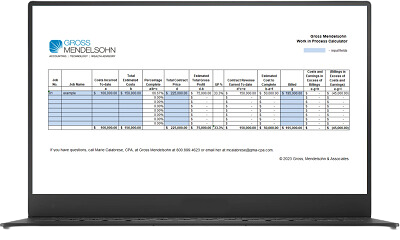A new lease accounting standard for construction companies and contractors takes effect on December 15, 2021. This article covers the rules of the new standard and how your company can prepare.
Why the Need for the New Rules?
The current accounting standards governing leases have long been a topic of discussion by financial statement users.
Many users criticize the rules for not requiring enough information about a company’s leasing transactions in financial statements. Also, the application of current standards results in various interpretations of the rules and how businesses classify and present leases in their annual reports. It is often difficult to determine the true financial impact of a company’s leasing activity.
In response to the issues raised about accounting for leases, the Financial Accounting Standards Board (FASB), the rule-setting body for accounting standards, sought to identify the problems with the current rules and develop new guidelines for improved lease reporting.
The result was a new accounting standard, issued in February 2016, which covers both lessees and lessors.
Who Do the New Rules Apply To?
While the accounting rules for lessors will remain generally unchanged, the rules for lessees will change significantly. For example, if you lease equipment used in your business, you will likely have to record those leases on the balance sheet as a right of use asset and a corresponding liability. Under the prior standard, you would only record rent expense for any costs associated with leasing the equipment. On the other hand, if you own equipment and earn revenue from leasing it out to others, the accounting for those transactions is largely unchanged.
The Nitty Gritty of the New Lease Accounting Rules
Under current lease rules, the accounting treatment of a lease may be different depending on how the lease is structured. Business owners are probably familiar with the terms “capital lease” and “operating lease.”
If the terms of the lease transfer ownership of the property to the lessee by the end of the lease term or if the lease term is approximately equal to the economic life of the asset, the lease is a capital lease. That means you must show the value of the leased asset, along with the related lease obligation, on your company’s financial statements. The asset depreciates similar to other assets owned by the entity.
Generally, if the lease is not a capital lease, you classify it as an operating lease. You’ll likely expense payments under operating leases as incurred, with little or no impact on a company’s balance sheet. These payments are normally included in the notes section, sometimes referred to as disclosures, of the financial statements. Additionally, leases with a lease term of less than 12 months do not fall under the current lease rules.
How Can Contractors Comply With the New Rules?
The new lease standard brings with it many changes, from accounting requirements to terminology.
Most importantly, lessees will be required to recognize lease assets and related lease liabilities on their balance sheet, regardless of the type of lease. Recording of both financing leases (the old capital lease) and operating leases will result in recording a “right-of-use” asset and the measurement of a lease liability at the present value of the lease payments called for under the lease.
On a company’s income statement, the payments on a financing lease reflect as depreciation of the right-of-use asset and interest expense on the lease liability. An operating lease reflects as a single lease expense.
The new rules also require expanded note disclosures in the financial statements. For leases with terms of less than 12 months, the business can elect not to report lease assets and liabilities.
Consideration should be given to the new definition of a lease, which is now defined as “a contract, or part of a contract, that conveys the right to control the use of identified property, plant or equipment for a period of time in exchange for consideration.” Right to control is the lessee’s right to the economic benefit from the use of the asset, and the right to direct the use of the asset. By definition, an identified asset is explicitly specified in a contract or implicitly specified at the time of the initiation of the lease term. Contractors might find that some of their current leases no longer meet the new definition of a lease.
Upon adoption of the new standard, you will need to use a “modified retrospective approach” where your business is required to apply the new standard and report all of its current leases and any future leases.
There are several elections that you can make and reliefs available in the standard relative to initial adoption, and you should be aware of your options in the period of transition to the new rules.
What Is the Deadline for Adopting the New Rules In Your Financial Statements?
The new lease rules will affect your business by something called the “effective date" — the date by which your business MUST adopt the new standards and present leases in financial statements under the new rules. This effective date, originally scheduled to take effect in December 2019, received an extension due to the COVID-19 pandemic. Now, for non-public companies, which covers most small businesses, the effective date is fiscal years beginning after December 15, 2021. For most construction companies, this will be the 2022 calendar year.
Keep in mind that the new standard will be required for all years presented in your company’s financial statement. Therefore, as many contractors present multiple years in their statements, any prior periods presented must reflect leases under the new rules.
How Can Contractors Work With a Lender or Surety Regarding These Changes?
Lenders and sureties are becoming more aware of the new lease standard, but it is a good idea to have discussions with your banker about potential impacts to your financial ratios and debt covenants. If your company has equipment leases that are required to go on the balance sheet, your financial statements could appear to have higher leverage (debt to equity ratio). A higher asset amount could mean a lower return on assets (net income to assets) and a need to recognize deferred tax assets or liabilities.
Sureties and lenders will have a more complete picture of your company’s financial situation if you show your leases on the balance sheet. You might need to have discussions regarding strategy for equipment, including whether to buy or lease and how those decisions will affect ratios and covenants. You can find out if covenants can be modified by adding new language or allowing the calculations to be made based on the accounting guidance that existed at the time of the agreement.
Why Should You Start Thinking About the New Rules NOW?
NOW is the time to start thinking about how the new rules will affect your business.
Upon adoption of the new rules, you might find that you suddenly have additional assets and liabilities on the books that were not there before. Additional liabilities can directly affect ratios and other financial covenants for banking and bonding purposes.
Keep in mind that there may be an impact on some of the new leases that your company enters into in the next few years when adopting the new rules. As an owner or financial officer of your business, you need to be aware of these changes in order to plan and eliminate the surprises this new standard might bring.
Contractors can proactively plan for implementing the new standard by charging someone in the business with learning the new rules and requirements, identifying all of the leases your business has, and evaluating those leases for conformity with the new standard.
Once you identify the leases, you can calculate the effect on your company’s financial reporting and develop a strategy for adopting the new standard.
Need Help?
Contact us here or call 800.899.4623.


